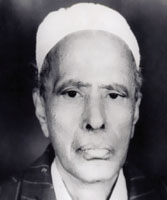
Faces & TracesInfluential Hadrami historian and national poet, Abdulqader Al-Sabban [Archives:2008/1184/Culture]
August 25 2008
 |
[email protected]
Yemeni historian, poet, author and researcher Abdulqader Mohammed Al-Sabban was born in 1921 in the northern Hadramout city of Sayun, where he began his primary education at age 7.
He joined Sayun's Al-Nahdha Al-Elmiya School in 1932, at the same time studying various Arabic sciences and Islamic religion with the help of his father. He then moved on to Ribat Bin Silm, a religious school hosting and teaching students, in Ghail Ba-Wazeer district.
Al-Sabban obtained his first job in 1937 as a scrivener at the Judicatory of Shibam, a city in northern Hadramout, where he later established Al-Minbar (The Pulpit) magazine.
In 1938, he participated in founding Al-Sharj University in Mukalla, the largest town in southern Hadramout. That same year, he also helped to found and headed Al-Shabab Club in Sayun.
He established Zahrat Al-Shabab (The Bloom) magazine in 1942, also serving as its editor-in-chief. In 1943, Al-Sabban took part in founding Sawt Al-Watan University in Sayun, also holding the post of its vice secretary.
Working as a teacher in Mukalla in 1944, after nine years, he participated in founding the Hadramout Farmers' Organization.
He then returned to Sayun and was appointed chairman of that city's municipality in 1957. In 1963, he partook in founding the Hadrami Laborers Association, as well as the National Printing and Publishing Company in Sayun.
After World War II, Al-Sabban immigrated to Saudi Arabia to work, where, beginning in 1964, he became secretary to a businessman, while continuing his studies, eventually earning degrees in journalism and accounting from Syria and Egypt.
Al-Sabban returned to Yemen in 1969, working as a lawyer before being appointed Sayun municipality's financial and legal affairs assistant in 1974. Beginning in 1978, he devoted himself to working as a historical researcher in Sayun's Culture Office.
In 1979, he was appointed manager of Sayun's branch of the General Organization of Antiquities, Museums and Manuscripts. Additionally, he participated in founding the Sayun branch of the Yemeni Authors and Writers Union, which he headed until 1987.
Al-Sabban's life was distinguished by prolific literary and cultural production, with more than 90 books covering history, poetry, jurisprudence and biographies.
Published in 1967, Al-Sabban's first divan was, “Fi Rabiya'a Al-'Aumr” (“In the Bloom of Youth”). It contains more than 50 poems he penned during his youth's bloom and discussing issues such as the joys of youth, the anguishes of expatriation and his nationalistic feelings.
The divan's romantic poems include, “Al-Samar fi Al-Qamar,” (“Soiree in the Moon”) and, “Al-Hubb Al-Khalid” (“The Immortal Love”), while its nationalistic poems include, “July 23,” “The Victory of Algeria” and “Unity Day.” It also includes elegizing poems, such as, “My Late Father,” and religious poems such as, “Exalted Ramadan,” and “The Prophet's Birthday (pbuh).”
Al-Sabban's second divan, “Fi Al-Tariq” (“On the Route”), still remains in handwritten form. His divan, “Thowaar fi Al-Yaman” (“Revolutionists in Yemen”), was issued in 1990 just after Yemen's reunification. It includes poems written and recited during different periods of Al-Sabban's life, including, “Sana'a,” “The Late Gamal Abdul Nasser” and “November 30.”
He also penned two poetic dramas: 1945's “Salwa and Mohammed, the Lover” and 1959's “The Livelihood.” Among his other poetic divans are, “Sana'a and Aden,” and, “Democratic Yemen is Speaking.”
One of Al-Sabban's most significant books about poetry is 1980's “Public Poetry in Hadramout: Research and Documentation,” published posthumously in 2007. In it, Al-Sabban documented numerous aspects of public poetry's heritage and reviewed its history, its standards and its major development periods.
Also published posthumously in 2001, his 1974 book, “The Literary Movement in Hadramout,” is a concise study of the phases in the Hadrami literary movement from pre-Islamic times until the end of the 14th Hijra century.
Al-Sabban's other documentary and social works include: “Historical Notifications About Wadi Hadramout” (1975), “A Comprehensive Look at Semi-desert Life” (1982), “Visits and Habits: Visiting the Prophet Hud (pbuh),” “Perusals in Literature and History,” “Al-Dan in the Hadramout” and “Mosques in Sayun.”
Among his jurisprudential works are, “The Jurisprudential Guide on the Route,” and, “Research on the Imprest's Issues.”
In 1988, Al-Sabban received the Order of Merit in arts and literature from the presidency staff of Aden's Supreme People's Council. He also received the 1989 Arab Historian Medal from the Arab Historians Union's secretariat-general, two 1993 certificates of appreciation from the U.S. cultural attache and the U.S. Embassy in Sana'a and the 1998 Sana'a Order of Merit in arts and literature.
In 2004, he was awarded posthumously by the General Center for Studies and Research in Sana'a. Likewise, he received a posthumous certificate from the Yemeni Union of Authors in appreciation for his momentous role in the union.
Al-Sabban died in Sayun on Jan. 13, 1999, at age 80. He was a Yemeni writer who must be imitated for his persistent intellectual, literary and historical activities; however, his work hasn't received the expected popularity because dozens of his valuable books remain in handwritten form.
Al-Sabban once wrote in one of his books, “I insist on being considered among other authors and poets and I'll never withdraw from this field. I offer samples of my poetry and I'll leave the assessment to my readers.”
——
[archive-e:1184-v:16-y:2008-d:2008-08-25-p:culture]


